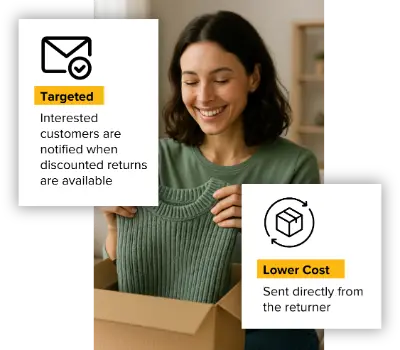Top 10 Ecommerce Returns Mistakes (and How to Fix Them)

Last updated on July 15, 2025

In this article
 5 minutes
5 minutes
- 1. Not Having a Clear Return Policy
- 2. Offering Free Returns Without Doing the Math
- 3. Making the Return Process a Hassle
- 4. Treating Returns as a Cost Instead of a Signal
- 5. Not Reselling What You Could
- 6. Refunding Too Slowly
- 7. Not Offering Exchanges
- 8. Forcing Customers to Pay for Damaged or Defective Returns
- 9. Ignoring International Return Complexities
- 10. Treating Returns Like a Backroom Issue
- Final Thought
- Frequently Asked Questions
Returns are no longer just a post-sale nuisance, they’re a defining part of your customer experience, your margin, and frankly, your brand. Yet so many brands treat returns like a cost center to ignore until it bites them.
I’ve been deep in the ecommerce trenches long enough to know this: if you don’t actively manage returns, they will manage you. Let’s walk through the top 10 mistakes I see over and over, and what you should do differently before your profit margins take a nosedive.
1. Not Having a Clear Return Policy
If your return policy is vague, buried, or just plain confusing, you’re not just frustrating your customers; you’re setting yourself up for chargebacks, bad reviews, and support nightmares.
Fix: Spell it out. Be upfront about what’s returnable, how long customers have, and how they initiate a return. Make it easy to find (footer link, FAQ, order confirmation email) and easy to understand (no legalese, no fine print tricks).
2. Offering Free Returns Without Doing the Math
Yes, free returns boost conversion, but they can destroy margins if you’re not careful. Too many brands offer them without understanding their actual cost per order.
Fix: Run the numbers. Factor in shipping costs, restocking labor, product condition loss, and processing time. Then decide if free returns should be conditional (only for first-time orders, only for full-price items, etc.).
Make Returns Profitable, Yes!
Cut shipping and processing costs by 70% with our patented peer-to-peer returns solution. 4x faster than traditional returns.
See How It Works3. Making the Return Process a Hassle
Ever tried returning something and had to print three pages, repack it just right, and get to the post office before 4 pm on a Tuesday? Your customers hate that too.
Fix: Make it stupid easy. Include a prepaid return label or offer printerless returns with QR codes. Let customers initiate the return online without calling support. Track returns in the same dashboard as orders.
4. Treating Returns as a Cost Instead of a Signal
Returns are data. They tell you what’s broken, literally and figuratively, in your business—sizing problems, misleading descriptions, shipping damage, and quality issues. Most brands never read the return reasons, let alone analyze trends.
Fix: Create a monthly returns report. Track reasons by SKU, channel, and geography. Spot patterns. If one item has a 20% return rate, figure out why and fix it.
5. Not Reselling What You Could
Returned items that are perfectly good shouldn’t be collecting dust or ending up in landfills. If you’re trashing usable inventory, you’re leaving money on the table.
Fix: Set up a reverse logistics plan to restock, refurbish, or resell items via outlets, liquidation partners, or marketplaces like eBay. Every recovered dollar counts.
6. Refunding Too Slowly
Waiting 14 days after receiving a return to issue a refund might protect your cash flow, but it destroys trust. Customers start wondering if they’ve been ghosted.
Fix: Tighten up the refund cycle. Ideally, within 2–3 days of receipt. Automate confirmations and refund notices. Build goodwill by being proactive.
7. Not Offering Exchanges
Here’s the thing: Most customers returning something still want what you sell; they just want the right version of it. If you don’t offer easy exchanges, you’re turning potential revenue into refunds.
Fix: Enable smart exchanges. Let customers swap for different sizes or styles right in the return portal. Offer free exchanges even if returns aren’t free. Keep the sale.
8. Forcing Customers to Pay for Damaged or Defective Returns
This one’s brutal. Customer gets a busted item, reaches out, and you hit them with a return shipping fee? Say goodbye to that lifetime value.
Fix: Have a clear damaged/defective policy. Cover return shipping and offer replacements ASAP. Yes, it costs you in the short term, but it’s a small price for loyalty.
Convert Returns Into New Sales and Profits
Our peer-to-peer returns system instantly resells returned items—no warehouse processing, and get paid before you refund.
I'm Interested in Peer-to-Peer Returns9. Ignoring International Return Complexities
Cross-border returns are a whole different beast—duties, taxes, restocking in the wrong region—it gets expensive fast. Many brands just say “no international returns” and hope no one notices.
Fix: If you’re selling internationally, design a return flow that works. Use local carriers and consolidation partners. Consider refunding without return in some low-cost, high-friction cases.
10. Treating Returns Like a Backroom Issue
Returns shouldn’t be siloed to warehouse staff or an outsourced 3PL with zero feedback loops. If marketing, product, CX, and ops aren’t all looking at return trends, you’re missing out.
Fix: Returns are a team sport. Share data across departments. Let product know what breaks. Let CX see trends. Let marketing tweak messaging to reduce mismatch expectations.
Final Thought
Returns aren’t going away. In fact, they’re becoming more critical to your brand than ever. Nail the return experience and you’ll win more loyalty, reduce costs, and create the kind of customer-centric business that actually survives the shakeouts we’re seeing in 2025.
You don’t have to be perfect. But you do have to be intentional.
Frequently Asked Questions
What’s the biggest return mistake ecommerce brands make?
Not having a clear, easily accessible return policy that sets customer expectations.
How can I reduce the cost of free returns?
Limit them to certain SKUs, order types, or customers, and audit the return rates by product.
Should I allow exchanges instead of just refunds?
Yes, exchanges help preserve the sale and increase customer satisfaction.
How fast should refunds be processed?
Ideally, within 2–3 days of receiving the returned item.
What should I do with returned inventory?
If it’s resellable, restock or liquidate it through the right channels to recover margin.

Turn Returns Into New Revenue





